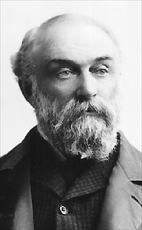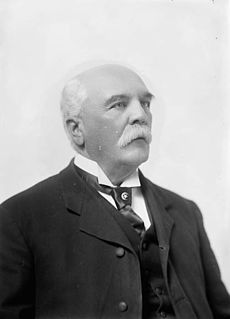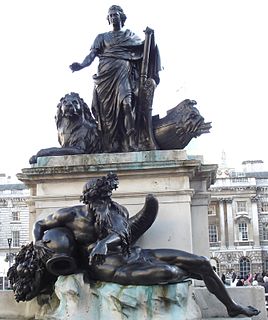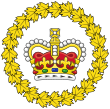
The Province of Lower Canada was a British colony on the lower Saint Lawrence River and the shores of the Gulf of Saint Lawrence (1791–1841). It covered the southern portion of the current Province of Quebec and the Labrador region of the current Province of Newfoundland and Labrador.

The House of Commons of Canada is a component of the Parliament of Canada, along with the Sovereign and the Senate. The House of Commons currently meets in a temporary Commons chamber in the West Block of the parliament buildings on Parliament Hill in Ottawa, while the Centre Block, which houses the traditional Commons chamber, undergoes a ten-year renovation.

The Parliament of Canada is the federal legislature of Canada, seated at Parliament Hill in Ottawa, the national capital. The body consists of the Canadian monarch, represented by a viceroy, the Governor General; an upper house, the Senate; and a lower house, the House of Commons. Each element has its own officers and organization. By constitutional convention, the House of Commons is dominant, with the Senate and monarch rarely opposing its will. The Senate reviews legislation from a less partisan standpoint and the monarch or viceroy provides royal assent to make bills into law.

Charles Poulett Thomson, 1st Baron Sydenham, was a British businessman, politician, diplomat and the first Governor General of the united Province of Canada.

The Leader of Her Majesty's Loyal Opposition is the leader of Canada's Official Opposition, the party possessing the most seats in the House of Commons that is not the governing party or part of the governing coalition. The current Leader of the Opposition is Andrew Scheer, M.P., who was elected Leader of the Conservative Party on May 27, 2017.

Central Canada is a region consisting of Canada's two largest and most populous provinces: Ontario and Quebec. Geographically, they are not at the centre of the country but instead overlaps with Eastern Canada toward the east. Due to their high populations, Ontario and Quebec have traditionally held a significant amount of political power in Canada, leading to some amount of resentment from other regions of the country. Before Confederation, the term "Canada" specifically referred to Central Canada. Today, the term "Central Canada" is less often used than the names of the individual provinces. This has led to a sense of Western alienation.

The Canadian federal election of 1925 was held on October 29 to elect members of the House of Commons of Canada of the 15th Parliament of Canada. Prime Minister William Lyon Mackenzie King's Liberal Party formed a minority government. This precipitated the "King–Byng Affair".

The 1980 Canadian federal election was held on February 18, 1980, to elect members of the House of Commons of Canada of the 32nd Parliament of Canada. It was called when the minority Progressive Conservative government led by Prime Minister Joe Clark was defeated in the Commons.

The Canadian federal election of 1926 was held on September 14 to elect members of the House of Commons of Canada of the 16th Parliament of Canada. The election was called following an event known as the King–Byng affair. In the 1925 federal election, Prime Minister William Lyon Mackenzie King's Liberal Party of Canada won fewer seats in the House of Commons of Canada than the Conservatives of Arthur Meighen. Mackenzie King, however, was determined to continue to govern with the support of the Progressive Party. The combined Liberal and Progressive caucuses gave Mackenzie King a plurality of seats in the House of Commons, and the ability to form a minority government. The agreement collapsed, however, following a scandal, and Mackenzie King approached the Governor-General, Baron Byng of Vimy, to seek dissolution of the Parliament. Byng refused on the basis that the Conservatives had won the largest number of seats in the prior election, and called upon Meighen to form a government.

The Canadian federal election of 1900 was held on November 7 to elect members of the House of Commons of Canada of the 9th Parliament of Canada. As a result of the election, the Liberal Party, led by Prime Minister Wilfrid Laurier, was re-elected to a second majority government, defeating the Conservative Party and Liberal-Conservatives led by Charles Tupper.

Alphonse Desjardins, PC was born in Terrebonne, Quebec and was mayor of Montreal from 1893 to 1894 and later a Canadian cabinet minister. He married Virginie Paré in 1864 and remarried Hortense Barsalou in 1880.
County of Ottawa was a federal and provincial electoral district in Quebec, Canada, which was represented in the Legislative Assembly of the Province of Canada from 1830 to 1867, in the House of Commons of Canada from 1867 to 1892, and in the Legislative Assembly of Quebec from 1867 to at least 1919.

William Andrew Charlton, was a Canadian lumber merchant, businessman and politician.

William Bullock Ives was a Canadian politician, who served in the House of Commons of Canada from 1878 to 1899. A member of the Conservative Party of Canada, he represented the electoral districts of Richmond—Wolfe from 1878 to 1891 and Sherbrooke from 1891 to 1899, and served as the President of the Privy Council and Minister of Trade and Commerce.
This is a list of leaders and office-holders of Canada. See also Canadian incumbents by year.

Michel Esdras Bernier, was a Canadian politician.
The Parliamentary Librarian of Canada is one of the key officials of the Parliament of Canada.

Dalby is a village and civil parish in the East Lindsey district of Lincolnshire, England. It is situated approximately 3 miles (5 km) north from the town of Spilsby. It is in the civil parish of Sausthorpe.

The statue of George III, Somerset House, formally titled George III and the River Thames, is a Grade I listed outdoor bronze sculptural group depicting King George III and Neptune or Father Thames, located in the quadrangle of Somerset House, London, England. The sculptor was John Bacon, and the statue was erected between 1778 and 1789.
















